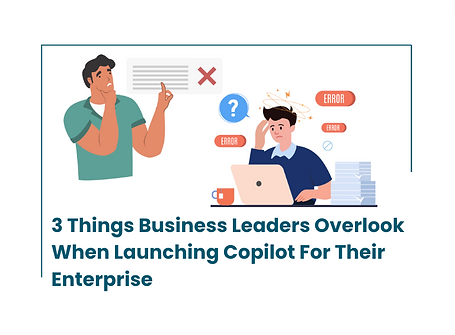Enterprises are progressively seeking and adopting cutting-edge digital solutions to maintain a competitive edge and foster innovation. One of the digital AI solutions that has sparked the most enthusiasm is Microsoft Copilot 365, as it’s poised to revolutionize the capabilities of the Microsoft Suite (including PowerPoint, Outlook, Word, and Teams), a staple for many business operations. However, the excitement of a new tool can often cloud the meticulous planning and strategy needed for its successful integration and deployment.
Integrating a new AI tool into the fabric of an enterprise is not without its challenges. For business leaders considering, or already in the throes of launching Copilot, it's essential to understand that this endeavor goes beyond mere adoption. Delving into our years of experience with clients who've embarked on similar journeys, we’ve witnessed common trends where even the most adept teams falter—typically, in the preparation phases before a software launch hits the ground running.
In this blog, we’ll explore three areas that are often overlooked and how addressing them can ensure a smoother implementation of Microsoft Copilot within your enterprise.
1. Evaluating Level of Readiness
Understanding if your organization is ready for Microsoft Copilot 365 is crucial. One of the most critical errors is overlooking the depth of system integration required for Copilot to truly operate at its fullest potential. Many leaders are captivated by the alluring features and advantages, operating under the belief that their existing Microsoft infrastructure, utilization, user permissions, and security policies will guarantee a seamless and effortless Copilot adoption. This could not be further from the truth!
Consider conducting a thorough assessment of your Microsoft environment to help you prepare for Microsoft Copilot's deployment at your organization, highlighting both the strengths of your Microsoft setup and the deficiencies that may impact your ability to safely utilize AI and optimize Copilot’s capabilities.
Imagine a scenario where you allocate significant resources towards Copilot, only to discover later that your internal content management isn’t structured correctly, or you’re missing the appropriate user permission guardrails. A well-executed assessment not only mitigates the risk of unforeseen obstacles but also ensures that your organization is primed to fully leverage Copilot’s capabilities.
Such oversight of important technical details will lead to delays, the risk your sensitive and confidential organizational data might be compromised, or the inability to use all available Copilot features. Thankfully there are solutions, like specialized AI consultancies, that will provide comprehensive guidance and best practices for preparing people, operations, and technology for Microsoft Copilot 365. Completing a readiness evaluation with an industry expert yields a more intentional and strategic integration and a more effective roll-out.
“Becoming an AI-powered organization doesn’t happen with the flip of a switch.” -Jared Spataro, Corporate VP of Modern Work & Business Applications at Microsoft.
2. User Training and Buy-In
In the corporate rush to adopt Microsoft Copilot, CEOs must prioritize comprehensive user training and strong organizational buy-in. User training extends beyond basic functionality, teaching employees how to enhance workflows, increase productivity, and ignite innovation with Copilot. Such training is not a one-off event; it needs to be an evolving program that grows with the release of new features and the users' proficiency with the tool.
To maximize the benefits of Copilot, CEOs should not only ensure technical training but also focus on its practical applications within the day-to-day responsibilities across different departments. It is essential to create a structured training program that emphasizes workflow integration and continues to support teams after the launch.
Furthermore, gaining organizational buy-in is critical. By articulating the strategic benefits of Copilot, leaders can cultivate widespread understanding and endorsement across the business. The goal is to nurture a company-wide recognition of Copilot's value, fostering an adaptive and forward-thinking corporate culture. This environment can be fostered by promoting experimentation, celebrating successes, and facilitating a community where team members exchange insights and optimal practices, allowing for quick identification and resolution of any issues that may arise during the integration.
3. A Long-Term Strategy To Build An AI-Powered Organization
Short-term focuses overshadow a critical aspect of launching Copilot—developing a long-term strategy that ensures the application’s sustained relevance. Many leaders consider the immediate benefits without looking at the broader technological landscape. A long-term strategy is vital for ensuring that the benefits of Copilot extend far beyond its initial deployment. It’s worth noting that the future of Copilot is already looking very promising given the results of recent studies. According to Microsoft’s Work Trend Index, 70% of Copilot users said that, after just three months, they were more productive, and 68% said it improved their work quality. Understanding the current benefits and developing a long-term strategy secures Copilot’s role as an indispensable asset rather than a temporary convenience.
To avoid these setbacks, leaders must focus on creating a dynamic strategy that adapts to the technology as well as the competitive and regulatory environments. Plan for regular reviews, updates, and continuous improvement initiatives to ensure Copilot remains aligned with the business's fluid nature of enterprise technology. Understanding current business needs and anticipating future organizational goals will also help leadership teams strategically analyze relevant Copilot capabilities. Integrating these foresight into the launch plan will position Copilot as an agile and evolutionary ally, rather than a static solution that becomes obsolete.
It’s undeniable that Microsoft Copilot is a transformative tool, offering remarkable benefits to enhance workplace productivity and collaboration. Launching the software requires strategic vision, technical readiness, supported integration, and proactive planning. Partnering with an experienced AI consultancy can bridge the gaps and shed light on the most impactful opportunity areas.
The demand for Copilot launch assistance is exactly why Louder Co. developed the Copilot Prep Playbook. Accompanied by our team of AI experts, we'll provide comprehensive guidance and best practices for preparing people, operations, and technology to ensure maximum adoption and utilization of AI capabilities. To learn more about our capabilities to help you roll out Copilot, contact Louder Co. today to get started!

